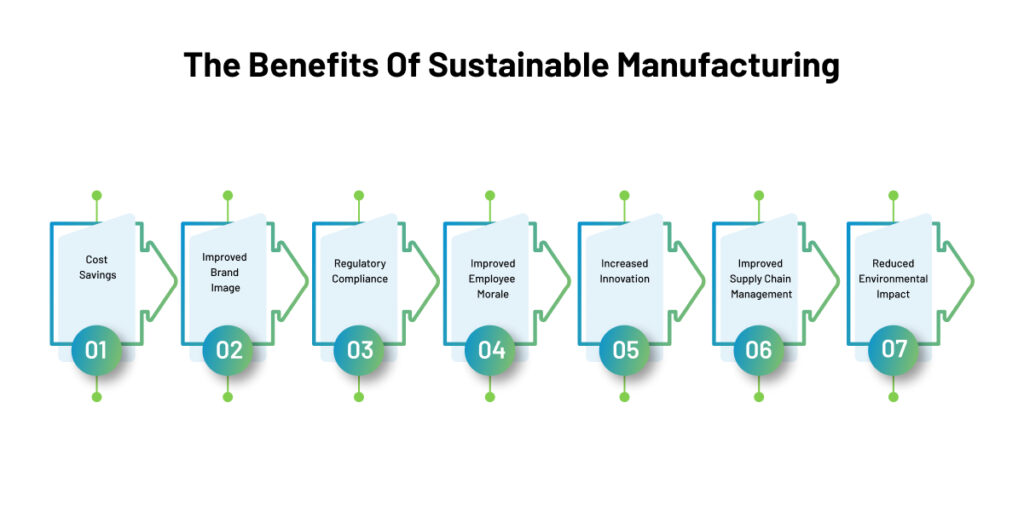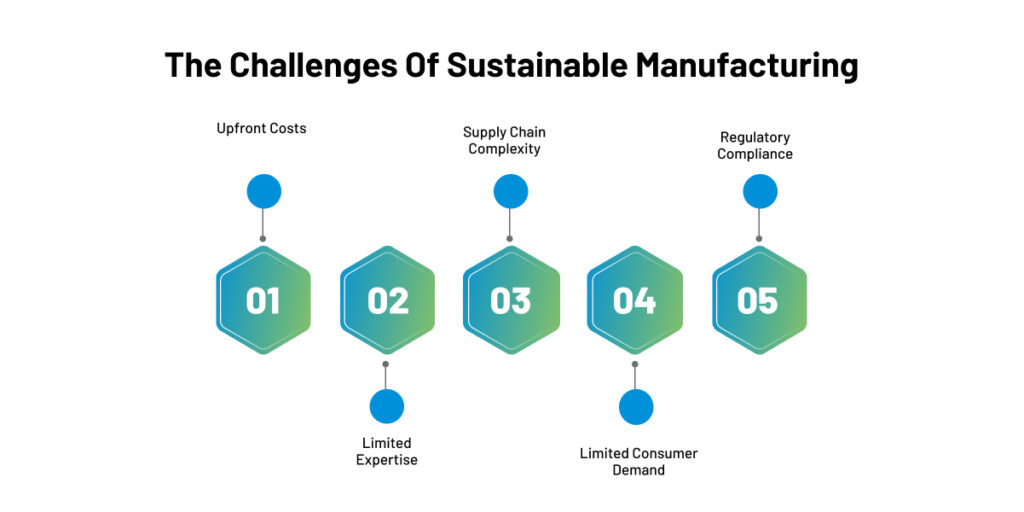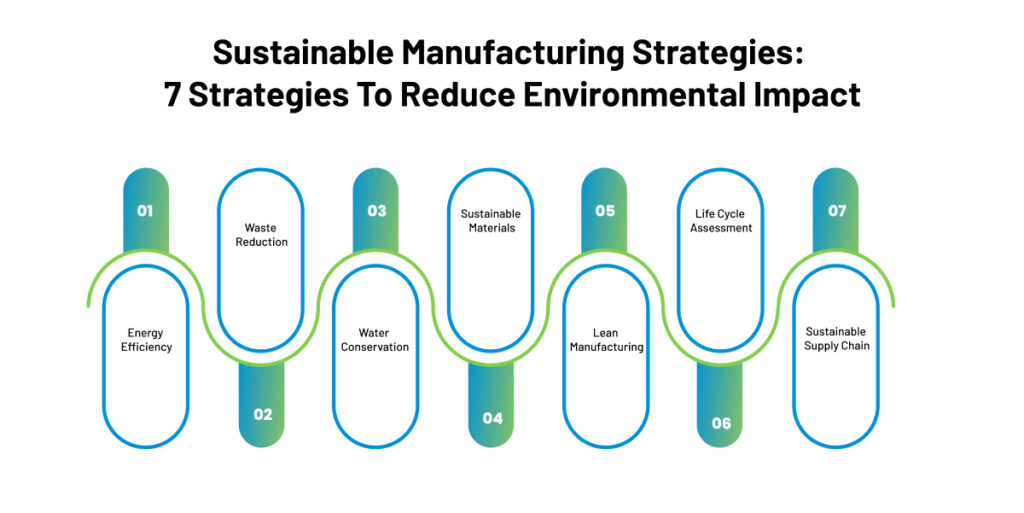Sustainable manufacturing has been essential to human life since the dawn of civilization. However, with the rise of industrialization and globalization, unsustainable manufacturing practices have become one of the most significant contributors to environmental degradation. As the world’s population grows, the demand for goods and environmental pressure increase. This is where the intersection of manufacturing and sustainability becomes critical for the future of our planet.
Sustainability in manufacturing refers to the practices and processes that minimize the environmental impact of manufacturing while also promoting economic growth and social responsibility. It is a concept that has gained increasing importance in recent years as people have become more aware of the consequences of our actions on the planet.
Sustainable manufacturing is not a new concept; it has been around for many years. However, it has gained increasing attention recently due to the growing concern over climate change and environmental degradation. Today, businesses that do not adopt sustainable practices risk being left behind in the race for consumer loyalty and the fight against climate change.
In this blog, we will explore the intersection of manufacturing and sustainability in-depth. We will discuss the importance of sustainability in manufacturing, the history of sustainability in manufacturing, and the challenges, current trends, and technologies transforming the manufacturing industry. We will also highlight the benefits of sustainable manufacturing practices.
Ready to read? Let’s get started!
Also, Read – From Automation to Digital Transformation: The Evolution of Industry 4.0
The History of Sustainability in Manufacturing: From Early Efforts to Modern Practices
Sustainability has become an increasingly important issue in manufacturing in recent decades, but the concept has a long history dating back to the industrial revolution of the 18th and 19th centuries. During this time, the rapid expansion of manufacturing led to significant environmental degradation, including air and water pollution, deforestation, and the depletion of natural resources.
The modern sustainability movement began in the 1960s, with the publication of Rachel Carson’s groundbreaking book “Silent Spring,” which warned of the dangers of pollution and the harmful effects of chemicals on the environment. This sparked a global movement to address environmental issues, including in manufacturing.
In the 1970s, the United States Environmental Protection Agency (EPA) was established, which set regulatory standards for pollution control and waste management in manufacturing. This led to the development of cleaner technologies and processes and the implementation of waste reduction and recycling programs.
In the 1980s, sustainability became increasingly important for businesses as consumers began to demand more environmentally-friendly products and services. This led to the development of eco-design and green manufacturing practices, which aim to reduce the environmental impact of products and processes throughout their lifecycle.
In the 1990s, the concept of sustainable development was introduced, which emphasizes the need for economic growth that is environmentally sustainable and socially responsible. This led to the development of sustainability frameworks, such as the triple bottom line, which considers business practices’ environmental, social, and economic impacts.
Today, sustainable manufacturing practices have become mainstream, with many businesses incorporating eco-friendly practices into their operations. This includes using renewable energy sources, waste reduction and recycling programs, and sustainable supply chain management practices.
At the core, the history of sustainability in manufacturing is long and complex, spanning several centuries. From early efforts to address environmental degradation to modern practices that aim to reduce the ecological impact of manufacturing, sustainability has become an increasingly important issue for businesses and consumers alike.
As we move forward, it is essential to continue to develop and implement sustainable manufacturing practices that are environmentally responsible, socially equitable, and economically viable.
Moving ahead, let’s look at the benefits of sustainable manufacturing.
The Benefits of Sustainable Manufacturing
Sustainable manufacturing is an approach to production that focuses on minimizing the environmental impact of manufacturing processes while maximizing economic and social benefits. In recent years, sustainable manufacturing has become an increasingly popular approach for businesses across various industries, and for a good reason.
Here are seven benefits that businesses can enjoy by adopting sustainable manufacturing practices.

Cost Savings: Sustainable manufacturing practices can lead to significant cost savings over time. By reducing waste, optimizing energy use, and using eco-friendly materials, businesses can save money on raw materials, energy bills, and waste disposal costs. For example, the electronics company Dell saved $3 million in 2018 by recycling plastic from water bottles and using it in their packaging materials.
Improved Brand Image: Sustainable manufacturing practices can improve a business’s brand image and reputation. Consumers are increasingly concerned about the environmental impact of their products and are more likely to support businesses that prioritize sustainability. A study by Nielsen found that 73% of millennials are willing to pay more for sustainable products. This can lead to increased sales and customer loyalty. For example, the outdoor clothing company Patagonia has built a reputation for environmental sustainability, which has helped them attract loyal customers and increase sales.
Regulatory Compliance: Governments worldwide are increasingly implementing environmental regulations to reduce pollution and protect natural resources. By adopting sustainable manufacturing practices, businesses can ensure that they comply with these regulations and avoid costly fines and legal penalties. For example, the pharmaceutical company GlaxoSmithKline reduced its water consumption by 45% by implementing sustainable manufacturing practices, which helped them comply with new regulations in India.
Improved Employee Morale: Sustainable manufacturing practices can also positively impact employee morale. Employees are more likely to feel proud of their work and company when they know they are contributing to a positive social and environmental impact. This can improve job satisfaction, increase productivity, and reduce turnover rates.
Increased Innovation: Sustainable manufacturing practices can also lead to increased innovation. Businesses are encouraged to find new and more efficient product production methods by prioritizing sustainability. This can lead to unique product designs, materials, and processes that can improve efficiency and reduce waste. For example, the automobile manufacturer Toyota developed a hybrid electric car, which has become a popular and eco-friendly alternative to traditional gas-powered vehicles.
Improved Supply Chain Management: Sustainable manufacturing practices can also improve supply chain management. By working with suppliers who prioritize sustainability, businesses can reduce their environmental impact and ensure that their products are produced ethically and responsibly. This can help businesses build stronger relationships with suppliers and reduce the risk of supply chain disruptions.
Reduced Environmental Impact: Finally, sustainable manufacturing practices can help businesses reduce their environmental impact. Businesses can minimize their carbon footprint and protect natural resources by reducing waste, minimizing energy use, and using eco-friendly materials. This can help businesses demonstrate their commitment to environmental sustainability and contribute to a more sustainable future for everyone.
Examples of Companies That Have Embraced Sustainable Manufacturing
As we read, sustainable manufacturing has become increasingly important for many businesses as they look for ways to reduce their environmental impact while improving their bottom line.
Here are three examples of companies that have reaped the benefits of sustainable manufacturing:
Dell and HP
Dell and HP are industry leaders in sustainable manufacturing practices. Both companies offer customers the ability to recycle old computers, printers, ink, and toner cartridges, reducing environmental waste. HP, in particular, has recycled over 875 million ink and toner cartridges, and has incorporated over 4.7 billion recycled plastic bottles and 114 million plastic clothes hangers into their ink and toner cartridge manufacturing process. Dell has committed to making 100% of its packaging and 50% of its products from recycled or renewable material by 2030.
Honda
Honda has made sustainability a top priority. Its “Green Path” initiative is designed to reduce the use of substances of concern and scarce natural resources, develop easier recycled products, and decrease CO2 emissions and water waste during manufacturing. For instance, Honda uses wind turbines at its Ohio plant to generate 10,000-megawatt hours of electricity per year. The company also moves 80% of vehicles from plant to dealership by train, reducing CO2 emissions by over 60%. Honda has developed the Honda Environmental Leadership Program to help dealers reduce energy and water use and achieve electric-grid-neutral status through the use of solar panels. Furthermore, Honda is a leading manufacturer of hybrid and zero-emission electric vehicles.
S.C. Johnson
S.C. Johnson is committed to reducing waste in its manufacturing processes. Since 2000, the company has worked to reduce manufacturing waste from its global facilities, aiming to cut waste by 70% by 2016 – a goal it achieved three years early. The company’s goal of sending no waste to landfills by 2021 was actually met in 2018/19. S.C. Johnson also created its Greenlist system, which rates the environmental and health effects of ingredients used in its products and even reformulates many of them. For example, after reviewing Saran Wrap, the company eliminated the use of almost 4 million pounds of PVDC annually. It has also reduced 1.8 million pounds of volatile organic compounds from Windex.
These examples of companies have shown us the benefits of sustainable manufacturing, but this does not mean that implementing these practices is without challenges. As companies strive to adopt sustainable manufacturing, they often face several challenges that make it difficult to fully integrate these practices into their operations. And what are those challenges? Let’s have a look.
Also, Read – The Role of Digital Twins in Driving the Future of Manufacturing Simulation and Digitization
The Challenges of Sustainable Manufacturing
Here are the five main challenges that manufacturers face in implementing sustainable practices:

Upfront Costs: One of the most significant challenges is the initial investment required to adopt sustainable practices. Companies may need to invest in new equipment, modify existing production lines, or hire additional staff to implement sustainable practices. While these investments can lead to long-term savings and benefits, they can be challenging to justify in the short term.
Limited Expertise: Implementing sustainable practices requires expertise that many manufacturers may not possess. These practices often involve complex systems and require knowledge of regulations, standards, and best practices. Companies may need to hire consultants or seek outside help to implement sustainable practices effectively.
Supply Chain Complexity: Sustainable manufacturing involves more than just the manufacturing process. It requires manufacturers to consider their entire supply chain, including sourcing raw materials and transporting finished goods. Identifying suppliers who meet sustainability standards can be challenging, and manufacturers may need to work closely with their suppliers to ensure that sustainability practices are implemented throughout the supply chain.
Limited Consumer Demand: While sustainability is becoming increasingly important to consumers, many may not be willing to pay more for sustainable products. This can make it challenging for manufacturers to justify the investment required to implement sustainable practices fully.
Regulatory Compliance: Many countries and regions have strict regulations surrounding sustainable manufacturing practices. Manufacturers must ensure that they comply with these regulations, which can be complex and time-consuming.
Traditional manufacturing processes have had a negative impact on the environment, including air and water pollution, deforestation, and increased carbon emissions. These processes have also contributed to the depletion of natural resources, which can have long-term consequences. Sustainable manufacturing aims to address these negative impacts and reduce the environmental footprint of manufacturing.
For example, traditional manufacturing processes in the fashion industry have been criticized for contributing to environmental problems such as pollution and waste. By implementing sustainable manufacturing practices, fashion companies can reduce waste, conserve resources, and minimize the negative impact of their operations on the environment.
In the automotive industry, manufacturers have embraced sustainable practices such as using recycled materials and producing electric cars. By doing so, they have reduced the environmental impact of their operations and appealed to consumers who are increasingly concerned about sustainability.
Overall, while there are challenges associated with sustainable manufacturing, the benefits of adopting these practices are clear. By reducing their environmental footprint, improving their bottom line, and enhancing their brand reputation, manufacturers can create a more sustainable future for themselves and the planet.
Sustainable Manufacturing Strategies: 7 Strategies to Reduce Environmental Impact
To achieve sustainable manufacturing, companies must adopt practices that reduce their environmental impact. Here are seven strategies that manufacturers can implement to achieve this goal:

Energy Efficiency: One of the simplest and most effective ways to reduce a manufacturer’s environmental footprint is by improving energy efficiency. This includes measures such as upgrading to energy-efficient lighting and equipment, optimizing heating and cooling systems, and implementing renewable energy sources like solar panels or wind turbines.
Waste Reduction: Another key strategy for sustainable manufacturing is reducing waste. This can be achieved through measures such as recycling, composting, and implementing circular economy principles that prioritize waste reduction and resource recovery.
Water Conservation: Water is a precious resource, and manufacturers can reduce their environmental impact by conserving water. This includes measures such as reducing water consumption, implementing water-efficient technologies, and treating and reusing wastewater.
Sustainable Materials: Sustainable materials are those that are environmentally friendly and have a reduced impact on the planet. Manufacturers can reduce their environmental impact by sourcing sustainable materials, reducing their use of non-sustainable materials, and implementing closed-loop material systems that prioritize reuse and recycling.
Lean Manufacturing: Lean manufacturing is a production system that minimizes waste and maximizes efficiency. By implementing lean manufacturing principles, manufacturers can reduce their environmental impact while also improving productivity and profitability.
Life Cycle Assessment: A life cycle assessment (LCA) is a comprehensive analysis of a product’s environmental impact throughout its entire life cycle, from raw materials extraction to end-of-life disposal. By conducting an LCA, manufacturers can identify areas of their production process that have the greatest environmental impact and implement measures to reduce that impact.
Sustainable Supply Chain: Manufacturers can reduce their environmental impact by implementing sustainable supply chain practices, such as sourcing from environmentally responsible suppliers, reducing transportation emissions, and implementing ethical and sustainable labor practices.
With that said, we know that implementing sustainable manufacturing strategies has become necessary for businesses to reduce their environmental impact and remain competitive in the market. By incorporating eco-friendly practices, businesses can benefit from cost savings, improved brand reputation, increased customer loyalty, and a better stakeholder relationship.
The Future of Sustainable Manufacturing: Trends and Predictions
The future of sustainable manufacturing is not only exciting but also crucial for the survival of our planet. As consumers become more environmentally conscious, manufacturing companies must adapt to remain competitive.
Incorporating sustainable manufacturing practices can bring numerous benefits to businesses, including reduced costs, improved brand reputation, and increased market opportunities. The 7 strategies outlined in this article provide a starting point for companies looking to reduce their environmental impact and improve their bottom line.
However, the industry’s evolution is far from over, and companies must continue to evolve their sustainability strategies to remain competitive. Implementing industry 4.0 technologies and custom manufacturing software development will be vital.
In the future, we can expect to see an increased emphasis on circular economy practices and the use of renewable energy sources. Companies prioritizing sustainability will have a competitive advantage and those that do not risk being left behind.
The future of sustainable manufacturing is not only necessary but also full of opportunities. With the help of industry 4.0 consulting and custom manufacturing software development companies, manufacturing companies can unlock these opportunities and thrive in a sustainable future.




